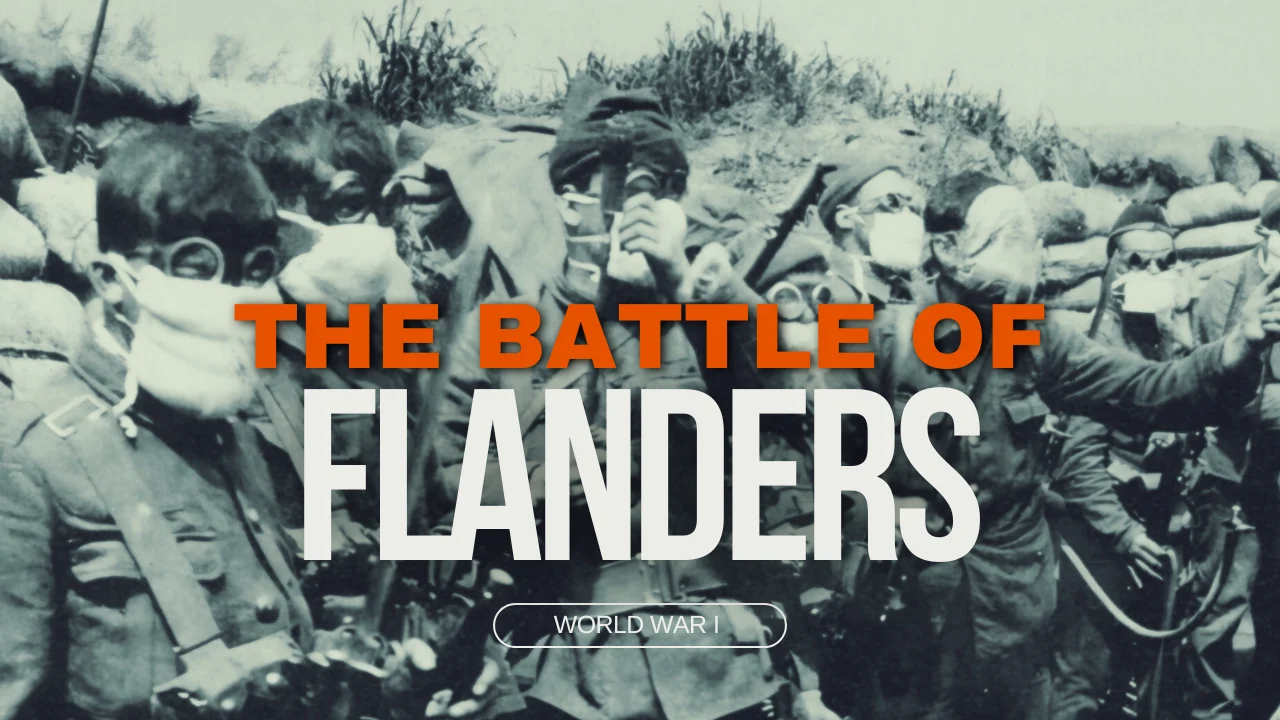Battle of Flanders

On October 19th, 1914, the German Army commenced its Schlieffen Plan, which called for their armies to invade Belgium with an objective of encircling French forces along the Franco-German border in order to win a swift and abbreviated victory over France, before moving east for a planned offensive against Russia on the Eastern Front. At first, German forces pushed back Belgian troops before defeating the British Expeditionary Forces or BEF at Mons, who in turn halted the German army from advancing on Paris at the First Battle of the Marne, which saw the first use of trench warfare during the First World War. On September 12th, the Allies failed in their attempts to halt the Germans at the Battle of the Aisne (n nah), which began the Race to the Sea, as both sides attempted to outflank the other.
In late September, French Marshal Joseph Joffre and British Field Marshal John French began discussions about the transfer of the BEF from Aisne to Flanders, in an effort to unify British forces and shorten Britain’s lines of communication with England, while defending Antwerp and the Channel Ports. Joffre eventually agreed to the transfer, provided French forces could make individual British units available for operations as soon as they arrived into the Flanders region of Belgium. Subsequent marches by the BEF were made at night, while billeted troops were forbidden to venture outside in during daylight hours. Britain’s insistence on secrecy proved to be a positive one on October 3rd, when an intercepted German wireless communique confirmed that German high command still believed that the BEF remained dug in along the Aisne River.
Arriving at the ancient Flemish city of Ypres by mid-October, with its fortifications guarding English Channel ports along with access to the North Sea and beyond, on October 19th, the Germans opened their Flanders offensive at Ypres and other nearby villages, while the Allies put up a steadfast resistance. In hindsight, the First Battle of Ypres can be divided into five distinct stages, beginning with first encounter battles from October 19th to the 21st, the Battle of Langemarck from October 21s to the 24th, the battles of La Bassee and Armentieres from October 10th through November 2nd. Coinciding with Allied offensives at Ypres and the Battle of Gheluvelt from October 29th to the 31st, followed by the last big German offensive, culminating in the Battle of Nonne Bosschen on November 11th.
While both sides of the conflict were armed with weapons of the Industrial Revolution, the defensive firepower of artillery and machine guns made for a bloody, indecisive fight, while the ability of both combatants to resupply themselves and replace casualties prolonged the battle for weeks. Ultimately, however, neither side had moved forces to Flanders fast enough to achieve a victory, leaving all armies involved desperately low on morale. While Germany outnumbered the Allies with a 5.4 million-man force opposed to the Allies’ 4.4 million-man force, by the end of fighting due to the onset of winter, German casualties stood at 134,315 killed, wounded or missing, while the Allies saw 139,717 killed, wounded or missing, making the First Battle of Ypres, a bloodbath standoff for both sides of the conflict.
In 1914, German chemist Walther Nernst made a proposal to Colonel Max Bauer, a German liaison to non-military scientists, that the German army could empty enemy trenches through the use of tear gas, and after observing tear gas tests under simulated battle conditions, chemist Fritz Haber proposed the use of heavier-than-air chlorine gas to expediently remove opposing forces from entrenched defensive positions. Embracing the idea of chemical warfare, German commander Erich von Falkenhayn gave a green light for the manufacture of 5,730 gas cylinders, to be sent to the Ypres salient that formed after the First Battle of Ypres, which was held by the Belgian army at Yser, with two French divisions to the north, while a Canadian division and two British divisions defended the east.
Comprised of four distinct battle actions, the Second Battle of Ypres began around 5:00 P.M. on April 22nd of 1915, when the German 4th Army released 171 tons of chlorine gas on a four-mile front between the hamlets of Langemark and Gravenstafel. Known as the Battle of Gravenstafel Ridge, French troops suffered 2,000-3,000 casualties from the ensuing gas cloud, with 800 to 1,400 fatalities, leading Colonel Henri Mordacq of the 90th Infantry Brigade to note of his troops that “their overcoats (were) thrown off or opened wide, their scarves pulled off, running like madmen, directionless, shouting for water, spitting blood, some even rolling on the ground making desperate efforts to breathe.”
The gas attack left an undefended four-mile gap in the French line, while the Germans, following well behind the gas cloud and breathing through cotton pads soaked with sodium thiosulfate solution, captured 2,000 French fighters and 51 guns in the villages of Langemark and Pilkem, followed by a second gas attack the following day that decimated the 13th Battalion Royal Highlanders of Canada. Ordered to counter-attack and defend the gap caused by both gas attacks, some 800 Canadian and Scottish soldiers attacked in waves of two companies each at 11:46 P.M. Charging blind without reconnaissance, the Allies were engaged by small arms fire from a wooded blind, prompting the Allies to engage in an bayonet charge that led to a 75% casualty rate for the Germans. By the end of the Battle of Gravenstafel, 5,000 Allied troops killed with 15,000 wounded.
From April 24th through May the 5th, a second engagement became known as the Battle of St. Julien, which had now become the front line after the gas attacks and Allied withdrawals of April 22nd, when on the morning of the 24th, Lance Corporal Frederick Fisher and a handful of men from the 13th Battalion Canadian Expeditionary Force prevented advancing German troops from moving through the village of St. Julien, before the Germans unleashed yet another chlorine gas attack on the re-formed Canadian line west of the village. Word was passed to Allied troops to urinate on their handkerchiefs and place them over their nose and mouth, which proved to be insufficient, allowing the Germans to take St. Julien before nightfall. The following day, British troops counter-attacked the village, and while they failed to retake St. Julien, they managed to create a new front line closer to the village. On April 26th, however, the 4th, 6th and 7th Battalions of the Northumberland Brigade at first gained a foothold in the village, until they were forced back after suffering 1,954 casualties.
Now known as the Battle of Frezenberg, from May 8th to the 13th, the Germans moved their field artillery and three army corps closer to the Frezenberg ridge, where they decimated Allied trench positions on the forward slope of the ridge, only to be repelled by valorous Allied survivors. During the third German assault on the morning of the 8th, the Allies were pushed back, leaving a two-mile gap in their defensive line, yet the German advance through the gap was ultimately repelled by counter-attacks from the Princess Patricia’s Canadian Light Infantry, followed by a night attack by the 10th Brigade. Of the 700 Canadians involved in the attack, only 150 survived.
The last of the engagements that made up the Second Battle of Ypres was the Battle of Bellewaarde, when on May 24th, the Germans unleashed another gas attack at Allied entrenchments in and around a place known as Shell Trap Farm. After Allied troops withdrew from the gas cloud, German forces advanced upon the British line to the north of the primary Battalion, only to be repelled by artillery fire and backup support from the 9th Argyll and Sutherland Highlanders.
During the nearly month-long Second Battle of Ypres, losses on both sides proved to be egregious, including 34,933 German casualties, as recorded by official historians of the Reichsarchive, while Britain recorded casualties of 59,275. By the end of fighting, French casualties stood at an estimated 10,000 killed, wounded or missing, while the Canadians witnessed an estimated 6,000, and while chemical warfare had first been used against the Russians, the use of chlorine gas and later Mustard gas would go on to be used by both combatants during the First World War, while the Second Battle of Ypres opened a dark new window into man’s ongoing ruthlessness against each other.
